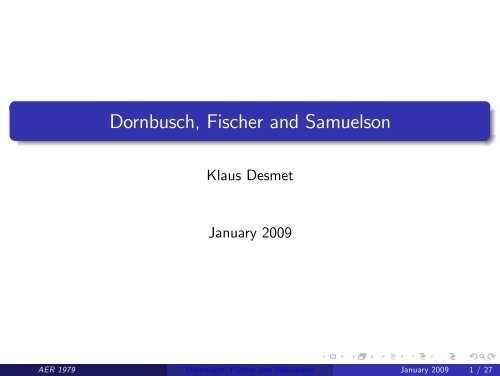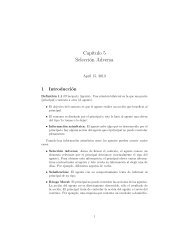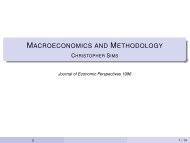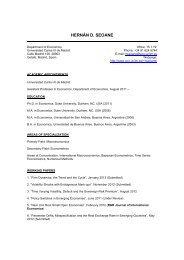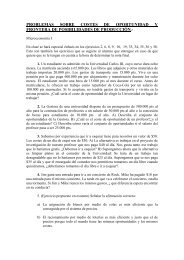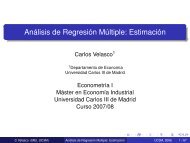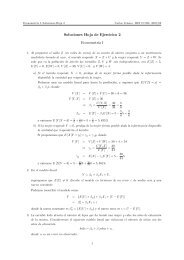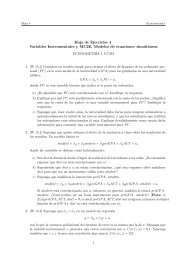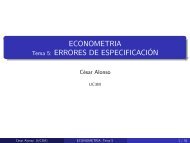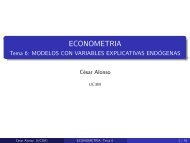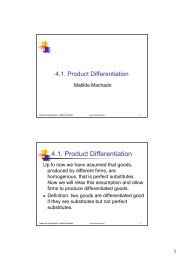Create successful ePaper yourself
Turn your PDF publications into a flip-book with our unique Google optimized e-Paper software.
<strong>Dornbusch</strong>, <strong>Fischer</strong> <strong>and</strong> <strong>Samuelson</strong><br />
Klaus Desmet<br />
January 2009<br />
AER 1979 () <strong>Dornbusch</strong>, <strong>Fischer</strong> <strong>and</strong> <strong>Samuelson</strong> January 2009 1 / 27
Outline<br />
1 Model of <strong>Dornbusch</strong>, <strong>Fischer</strong> <strong>and</strong> <strong>Samuelson</strong> (1979).<br />
1 Ricardian model with continuum of goods.<br />
2 Nontraded goods <strong>and</strong> transfers.<br />
2 Applications.<br />
1 Costs of eliminating trade de…cit.<br />
2 The US trade de…cit <strong>and</strong> the value of the dollar.<br />
AER 1979 () <strong>Dornbusch</strong>, <strong>Fischer</strong> <strong>and</strong> <strong>Samuelson</strong> January 2009 2 / 27
Technology<br />
Continuum of goods z located on unit interval [0,1].<br />
Two countries: Home <strong>and</strong> Foreign (‘*’)<br />
Unit labor requirements to produce z are a(z) <strong>and</strong> a (z).<br />
Goods z are ordered in order of diminishing comparative advantage of<br />
Home:<br />
A(z) =<br />
a (z)<br />
a(z)<br />
where A 0 (z) < 0<br />
AER 1979 () <strong>Dornbusch</strong>, <strong>Fischer</strong> <strong>and</strong> <strong>Samuelson</strong> January 2009 3 / 27
Specialization<br />
Wages in Home <strong>and</strong> Foreign: w <strong>and</strong> w .<br />
Relative wage of Home: ω = w/w .<br />
Home produces z if a(z)w < a (z)w . In other words, Home<br />
produces if its relative wage is smaller than its relative productivity:<br />
ω A(z)<br />
Denote ˜z as the cuto¤ between goods produced in Home <strong>and</strong> goods<br />
produced in Foreign, where<br />
ω = A(˜z) (1)<br />
AER 1979 () <strong>Dornbusch</strong>, <strong>Fischer</strong> <strong>and</strong> <strong>Samuelson</strong> January 2009 4 / 27
Relative prices<br />
If both z <strong>and</strong> z 0 are produced in Home:<br />
P(z)<br />
P(z 0 wa(z)<br />
=<br />
) wa(z 0 a(z)<br />
=<br />
) a(z 0 )<br />
If z is produced in Home <strong>and</strong> z 00 is produced in Foreign:<br />
P(z)<br />
P(z 00 wa(z)<br />
=<br />
) w a (z 00 a(z)<br />
= ω<br />
) a (z 00 )<br />
These relative prices will be relevant for welfare analysis.<br />
AER 1979 () <strong>Dornbusch</strong>, <strong>Fischer</strong> <strong>and</strong> <strong>Samuelson</strong> January 2009 5 / 27
Preferences<br />
Cobb-Douglas preferences.<br />
Denote by b(z) the income share spent on good z, where<br />
b(z) = b (z) <strong>and</strong> R 1<br />
b(z)dz = 1.<br />
0<br />
Range of commodities produced in Home: (0, ˜z).<br />
Fraction of income spent on goods produced in Home:<br />
θ(˜z) =<br />
Z ˜z<br />
0<br />
b(z)dz<br />
Fraction of income spent on goods produced in Foreign:<br />
1 θ(˜z) =<br />
Z 1<br />
˜z<br />
b(z)dz<br />
AER 1979 () <strong>Dornbusch</strong>, <strong>Fischer</strong> <strong>and</strong> <strong>Samuelson</strong> January 2009 6 / 27
Clearing of goods markets<br />
Income of Home is equal to spending on goods produced at Home:<br />
wL = θ(˜z)(wL + w L )<br />
Equivalent to trade balances: value of Home imports is equal to value<br />
of Home exports.<br />
This can be re-written as:<br />
(1 θ(˜z))wL = θ(˜z)w L<br />
ω = θ(˜z) L<br />
1 θ(˜z) L<br />
L<br />
= B(˜z; ) (2)<br />
L<br />
Interpretation: (i) the greater ˜z, the more goods Home produces, so<br />
that the greater the dem<strong>and</strong> for labor in Home, <strong>and</strong> the higher the<br />
relative wage of Home; (ii) increasing ˜z pushes Home into a trade<br />
surplus, so that its wages must increase to eliminate that trade<br />
surplus.<br />
AER 1979 () <strong>Dornbusch</strong>, <strong>Fischer</strong> <strong>and</strong> <strong>Samuelson</strong> January 2009 7 / 27
Equilibrium<br />
Two equations in two unknowns: equations (1) <strong>and</strong> (2). Recall:<br />
ω = A(˜z)<br />
ω = θ(˜z) L<br />
1 θ(˜z) L<br />
= B(˜z; L<br />
L )<br />
These equations depend on the technologies, A(z), the preferences,<br />
θ(z), <strong>and</strong> the relative size, L /L.<br />
AER 1979 () <strong>Dornbusch</strong>, <strong>Fischer</strong> <strong>and</strong> <strong>Samuelson</strong> January 2009 8 / 27
Equilibrium<br />
AER 1979 () <strong>Dornbusch</strong>, <strong>Fischer</strong> <strong>and</strong> <strong>Samuelson</strong> January 2009 9 / 27
Comparative statics 1: increase relative size Foreign<br />
AER 1979 () <strong>Dornbusch</strong>, <strong>Fischer</strong> <strong>and</strong> <strong>Samuelson</strong> January 2009 10 / 27
Comparative statics 1: increase relative size Foreign<br />
Home produces a smaller range of products. Its relative wage must<br />
therefore increase.<br />
The increase in the relative size of Foreign would lead to an increase<br />
in dem<strong>and</strong> in Home. This pushes up the dem<strong>and</strong> for labor in Home,<br />
<strong>and</strong> thus the relative wage.<br />
Alternative interpretation: the increase in dem<strong>and</strong> for goods produced<br />
in Home pushes Home into a trade surplus. To keep trade balanced,<br />
income in Home should increase, so that Home starts importing more.<br />
AER 1979 () <strong>Dornbusch</strong>, <strong>Fischer</strong> <strong>and</strong> <strong>Samuelson</strong> January 2009 11 / 27
Comparative statics 1: increase relative size Foreign<br />
Real income in Home increases.<br />
Goods it bought from Home <strong>and</strong> still buys from Home: no change.<br />
w 1<br />
=<br />
wa(z) a(z)<br />
Goods it already bought from Foreign <strong>and</strong> still buys from Foreign.<br />
w ω<br />
=<br />
w a (z) a (z)<br />
where ω increases, so that real wage increases.<br />
Goods it previously bought from Home <strong>and</strong> now buys from Foreign.<br />
w ω<br />
=<br />
w a (z) a (z)<br />
where ω/a (z) > 1/a(z), otherwise it would continue to buy from<br />
Home. Since before it bought from Home, the real wage was 1/a(z),<br />
so that once again the real wage has increased.<br />
AER 1979 () <strong>Dornbusch</strong>, <strong>Fischer</strong> <strong>and</strong> <strong>Samuelson</strong> January 2009 12 / 27
Comparative statics 2: technological progress Foreign<br />
Proportional decrease in a (z) for all z.<br />
A(z) schedule shifts proportionately downwards.<br />
Relative wage of Home, ω, goes down (proportionately less than the<br />
technological progress), <strong>and</strong> Home produces a smaller range of goods.<br />
Interpretation: at the initial wage technological progress in Foreign<br />
implies the loss of comparative advantage in some industries, <strong>and</strong><br />
thus a decrease in dem<strong>and</strong> for Home labor. This pushes down the<br />
wages. (Alternative explanation: the loss of comparative advantage<br />
implies initially a trade de…cit in Home, so that wages must drop to<br />
rebalance trade.)<br />
AER 1979 () <strong>Dornbusch</strong>, <strong>Fischer</strong> <strong>and</strong> <strong>Samuelson</strong> January 2009 13 / 27
Comparative statics 2: technological progress Foreign<br />
Real income in Home increases.<br />
Goods it bought from Home <strong>and</strong> still buys from Home: no change.<br />
w 1<br />
=<br />
wa(z) a(z)<br />
Goods it already bought from Foreign <strong>and</strong> still buys from Foreign.<br />
w ω<br />
=<br />
w a (z) a (z)<br />
Decrease in ω is less than increase in a (z): real wage increases.<br />
Goods it previously bought from Home <strong>and</strong> now buys from Foreign.<br />
w ω<br />
=<br />
w a (z) a (z)<br />
where ω/a (z) > 1/a(z), otherwise it would continue to buy from<br />
Home. Since before it bought from Home, the real wage was 1/a(z),<br />
so that once again the real wage has increased.<br />
AER 1979 () <strong>Dornbusch</strong>, <strong>Fischer</strong> <strong>and</strong> <strong>Samuelson</strong> January 2009 14 / 27
Comparative statics 2: technological progress in Foreign<br />
Real income in Foreign increases.<br />
Goods it bought in Foreign <strong>and</strong> still buys from Foreign: improves.<br />
w 1<br />
=<br />
w a (z) a (z)<br />
Goods it bought in Home <strong>and</strong> still buys in Home.<br />
w 1<br />
=<br />
wa(z) ωa(z)<br />
where ω is lower, so real wage is higher.<br />
Goods it previously bought from Home <strong>and</strong> now buys from Foreign.<br />
w 1<br />
=<br />
w a (z) a (z)<br />
where 1/a (z) > 1/(ωa(z)), otherwise it would still buy from<br />
Home. Since 1/(ωa(z)) has gone up, real wage has increased.<br />
AER 1979 () <strong>Dornbusch</strong>, <strong>Fischer</strong> <strong>and</strong> <strong>Samuelson</strong> January 2009 15 / 27
Unilateral transfers<br />
Foreign makes unilateral transfer to Home.<br />
Technology does not change. Therefore, the A(˜z) schedule does not<br />
change.<br />
Total income does not change. Because of homothetic preferences,<br />
θ(˜z) does not change, <strong>and</strong> therefore the B(˜z) schedule does not<br />
change either.<br />
Result: unilateral transfers does not change the relative wages, the<br />
relative prices, <strong>and</strong> the specialization patterns. (Of course, Home<br />
becomes better o¤, <strong>and</strong> Foreign becomes worse o¤.)<br />
AER 1979 () <strong>Dornbusch</strong>, <strong>Fischer</strong> <strong>and</strong> <strong>Samuelson</strong> January 2009 16 / 27
Nontraded goods<br />
There is still a continuum of traded goods, indexed by z, located on<br />
the unit interval [0,1]. However, now there are also a bunch of<br />
nontraded goods.<br />
A fraction k of income is spent on traded goods, <strong>and</strong> a fraction 1 k<br />
on nontraded goods, so that:<br />
k =<br />
No change to the A(˜z) schedule.<br />
Z 1<br />
0<br />
b(z)dz<br />
AER 1979 () <strong>Dornbusch</strong>, <strong>Fischer</strong> <strong>and</strong> <strong>Samuelson</strong> January 2009 17 / 27
Nontraded goods<br />
Trade balance is now di¤erent:<br />
(k θ(˜z))wL = θ(˜z)w L<br />
This changes the B(˜z) expression slightly:<br />
ω = θ(˜z) L<br />
k θ(˜z) L<br />
L<br />
= B(˜z; ) (3)<br />
L<br />
Can easily do the same comparative statics as in case without<br />
nontraded goods.<br />
AER 1979 () <strong>Dornbusch</strong>, <strong>Fischer</strong> <strong>and</strong> <strong>Samuelson</strong> January 2009 18 / 27
Transfers in the presence of nontraded goods<br />
Home receives transfer T from Foreign, where T is measured in terms<br />
of foreign labor.<br />
Spending on imports by Home is equal to spending on imports by<br />
Foreign plus transfers. (In other words, Home runs a trade de…cit of<br />
T.)<br />
(k θ(˜z))(ωL + T ) = θ(˜z)(L T ) + T<br />
where foreign wage has been normalized to 1.<br />
The B(˜z) schedule then becomes:<br />
ω =<br />
1 k T<br />
k θ(˜z) L<br />
θ(˜z) L<br />
+<br />
k θ(˜z) L<br />
= B(˜z; L /L, T ) (4)<br />
AER 1979 () <strong>Dornbusch</strong>, <strong>Fischer</strong> <strong>and</strong> <strong>Samuelson</strong> January 2009 19 / 27
Transfers in the presence of nontraded goods<br />
The expression (4) implies that a transfer from Foreign to Home<br />
shifts up the B(˜z) schedule.<br />
The relative wage of Home, ω, increases, <strong>and</strong> Home produces a<br />
smaller range of goods.<br />
Because of the presence of nontraded goods, transfers lead to an<br />
increase in dem<strong>and</strong> for Home produced goods, <strong>and</strong> a decrease in<br />
dem<strong>and</strong> for Foreign produced goods. This pushes up the relative<br />
wage in Home.<br />
AER 1979 () <strong>Dornbusch</strong>, <strong>Fischer</strong> <strong>and</strong> <strong>Samuelson</strong> January 2009 20 / 27
Transfers in the presence of nontraded goods<br />
Alternative explanation: at the initial wages, increase in imports is<br />
(k θ(˜z) times transfers (part of increased spending at Home is<br />
spent on Home produced nontradeable goods) <strong>and</strong> decrease in<br />
exports is θ(˜z) times transfers.<br />
Since k θ + θ < 1, the change in net imports by Home is smaller<br />
than the transfer received. Given that Home’s income has gone up by<br />
the amount of the transfer, we have that “value of imports by Home”<br />
is smaller than “value of imports by Foreign plus transfers”. To<br />
rebalance this equality, Home’s imports should increase, so that<br />
relative wage of Home should increase.<br />
AER 1979 () <strong>Dornbusch</strong>, <strong>Fischer</strong> <strong>and</strong> <strong>Samuelson</strong> January 2009 21 / 27
Transfers <strong>and</strong> terms of trade<br />
The increase in the relative wage of Home (the receiving country)<br />
implies an increase in the relative price of Home’s exports.<br />
Recall that if z is produced in Home <strong>and</strong> z 00 is produced in Foreign:<br />
P(z)<br />
P(z 00 wa(z)<br />
=<br />
) w a (z 00 a(z)<br />
= ω<br />
) a (z 00 )<br />
Therefore, Home experiences an improvement in its terms of trade.<br />
This validates the Keynes view on transfers: the receiving country<br />
gains twice, once because it receives transfers, <strong>and</strong> once because its<br />
terms of trade improve.<br />
AER 1979 () <strong>Dornbusch</strong>, <strong>Fischer</strong> <strong>and</strong> <strong>Samuelson</strong> January 2009 22 / 27
Transfers <strong>and</strong> trade de…cits<br />
Recall the trade balance expression in the presence of transfers:<br />
(k θ(˜z))(ωL + T ) = θ(˜z)(L T ) + T<br />
where imports by Home are (k θ(˜z))(ωL + T ) <strong>and</strong> exports by<br />
Home are θ(˜z)(L T ).<br />
This implies that Home has a trade de…cit of T .<br />
A trade de…cit can thus be interpreted as a transfer received from the<br />
rest of the rest of the world.<br />
AER 1979 () <strong>Dornbusch</strong>, <strong>Fischer</strong> <strong>and</strong> <strong>Samuelson</strong> January 2009 23 / 27
Transfers <strong>and</strong> trade de…cits<br />
Transfers lead to an increase in the relative wage of Home (receiving<br />
country).<br />
Higher relative wage of Home implies an increase in the relative prices<br />
of Home exports, compared to Foreign exports. In other words, the<br />
terms of trade of Home improve.<br />
Higher relative wage of Home also pushes up the relative price of<br />
nontraded goods in Home. As a result, there is an increase in the<br />
overall relative price level of Home, compared to Foreign.<br />
AER 1979 () <strong>Dornbusch</strong>, <strong>Fischer</strong> <strong>and</strong> <strong>Samuelson</strong> January 2009 24 / 27
The cost of eliminating the trade de…cit<br />
Direct cost: lose the transfers T .<br />
Indirect cost through change in terms of trade: worsening of terms of<br />
trade.<br />
Indirect bene…t through lowering of relative price of nontraded goods.<br />
This latter e¤ect is not discussed in DFS.<br />
See Dekle, Eaton <strong>and</strong> Kortum (2008).<br />
AER 1979 () <strong>Dornbusch</strong>, <strong>Fischer</strong> <strong>and</strong> <strong>Samuelson</strong> January 2009 25 / 27
Eliminating the US trade de…cit <strong>and</strong> the dollar<br />
Eliminating the US trade de…cit will lead to a drop in the relative<br />
price level in the US.<br />
This is equivalent to a real depreciation of the dollar.<br />
The real exchange rate of the dollar versus, say, the euro can be<br />
written as:<br />
ε USD /EUR = E USD /EUR PEUR<br />
PUS<br />
where ε is the real exchange rate, E is the nominal exchange rate, <strong>and</strong><br />
P are the price levels.<br />
Eliminating the US trade de…cit, leads to an increase in ε, <strong>and</strong> thus a<br />
real depreciation of the dollar.<br />
This real depreciation can either be obtained by (i) lower in‡ation in<br />
the US, relative to the EU, or by (ii) a nominal depreciation of the<br />
dollar versus the euro.<br />
AER 1979 () <strong>Dornbusch</strong>, <strong>Fischer</strong> <strong>and</strong> <strong>Samuelson</strong> January 2009 26 / 27
Eliminating the US trade de…cit <strong>and</strong> the dollar<br />
If both the Fed <strong>and</strong> the ECB have a target level of in‡ation, then the<br />
real depreciation of the dollar will be obtained by (ii), i.e., by a<br />
nominal depreciation of the dollar.<br />
This is the argument of Obstfeld <strong>and</strong> Rogo¤ (2003) <strong>and</strong> of Krugman<br />
(2006) of why the dollar will decline when the US trade de…cit<br />
disappears.<br />
AER 1979 () <strong>Dornbusch</strong>, <strong>Fischer</strong> <strong>and</strong> <strong>Samuelson</strong> January 2009 27 / 27


